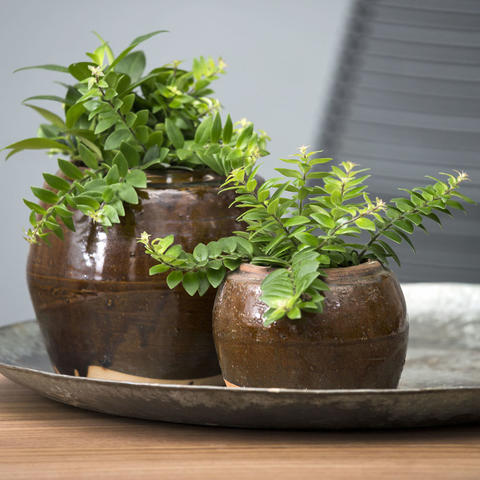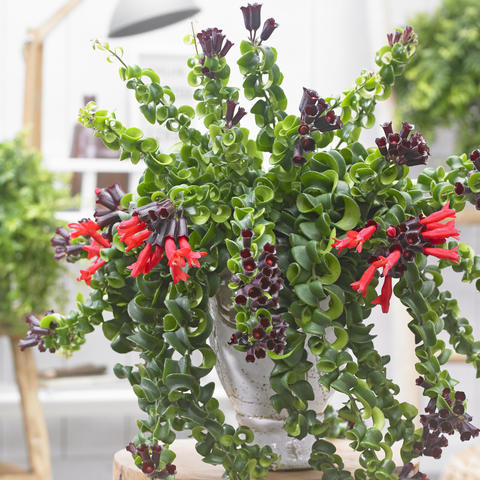Lipstick Plant
The Lipstick plant reaches lofty heights as a hanging basket plant indoors and impresses with its brightly colored exotic flowers.
Factsheet
- Growth characteristics
-
- hanging
- Flower color
-
- yellow
- orange
- red
- Flowering time (month)
-
- June to September
- Flower shape
-
- Bundles
- tubular
- Leaf color
-
- green
- page format
-
- egg-shaped pointed
- Sheet properties
-
- evergreen
- Fruit shape
-
- Capsule
- Light
-
- scattered light
- Soil type
-
- sandy
- Soil Moisture
-
- moderately dry
- Nutrient requirements
-
- low in nutrients
- Humus
-
- low humus
- Decorative or utility value
-
- Flower Decoration
- Use
-
- Interior greening
- Planters
- Winter garden
- Warm House
- Garden style
-
- Pot garden
The Lipstick plant (Aeschynanthus) is native to the rainforests of Asia and Oceania. Botanists have tended to discover members of this genus in China, India, the Philippines, Java, Malaysia, New Guinea, and the Solomon Islands. And new species are still being added. The number of Aeschynanthus species lies somewhere between 140 and 185. The genus belongs to the gesneriad family (Gesneriaceae). Aeschynanthus radicans and various cultivated forms are commonly seen as houseplants.
Lipstick plants are rarely found rooted in the ground in the wild. They usually grow as epiphytes on other plants or settle on stones and rocks as lithophytes. Aeschynanthus is therefore often grown indoors as a hanging plant. The shoots are more or less branched, growing to a length of 24 inches.
The Lipstick plant forms opposite pairs of leaves. Depending on the species and variety, the pointed ovate leaves can be soft or downy. However, they most commonly have thick cuticles.

In the summer months, from around June to September, Aeschynanthus species form tubular flower clusters that hang from the shoots. The flowers of the Lipstick plant are mostly red, but there are also varieties with orange-red or yellow flowers.
The Lipstick plant is pollinated by birds in the wild. The capsule fruits very rarely form when the plant is grown indoors.
The Lipstick plant needs a warm and bright location with a high humidity all year round. Originally native to the rainforest, the plants do not like direct sunlight at all. The temperature should always be between 68 and 77 degrees Fahrenheit. To stimulate flower formation, Aeschynanthus should be kept in cooler conditions for a month in winter (59 to 64.5 degrees Fahrenheit) and not watered during this time. Ideal places include conservatories, a warm and humid greenhouse, a bright bathroom, or a window (out of direct sunlight).
In terms of substrate, the Lipstick plant prefers potting soil loosened with cactus soil or clay pebbles. It is important to use a good substrate with good drainage.
Aeschynanthus should not be allowed to dry out or stand in water, you should therefore use your intuition when it comes to watering the plant. Important: only treat the heat-loving plant to temperate water. Water more sparingly in winter. A high humidity is equally important, this can be achieved by regularly spraying the Lipstick plant. Also recommended: using a damp gravel bed as a saucer in the hanging basket.
The Lipstick plant does not have high nutrient requirements. Fertilizing the plant with a low dose of fertilizer every two to three weeks between March and August is perfectly sufficient.
It is time to repot Aeschynanthus once the pot has completely rooted through. The best time is between February and March, or after the flowering period. Remove the root ball from the pot, shake off any old soil from the roots, and cut off all dead roots. Replant in a slightly larger container.

The Lipstick plant does not actually need pruning. However, if some shoots become too long, it is best to trim them in spring with a sharp knife or a good pair of pruning shears. But at least one third of the shoots should remain the original length.
The Lipstick plant should never be moved during the flowering period. Experience has shown that even small changes of location can cause the plants to drop their buds and flowers.
There are many different hybrids of the Lipstick plant and each florist has a special selection. Our tip: Have a look around the shop to see which variety you like best. Red flowering Lipstick plants are the most common, but there are also orange-red and yellow varieties.

It is best to propagate Aeschynanthus from terminal cuttings in early summer. Put approximately four-inch long cuttings in potting soil and place them in a bright spot. It is important to keep the soil warm. Another option is to simply put a few shoots on some consistently warm, humid soil, and to wait until roots form at the leaf nodes.
The Lipstick plant is particularly sensitive to low humidity. Sucking pests in particular, such as thrips or spider mites, can thrive in these conditions. It is best to simply brush off occasional aphids using a cloth. Soil moisture and temperature changes can cause the lipstick plant to suddenly drop its flowers. You should therefore keep a close eye on the plant at this time.

